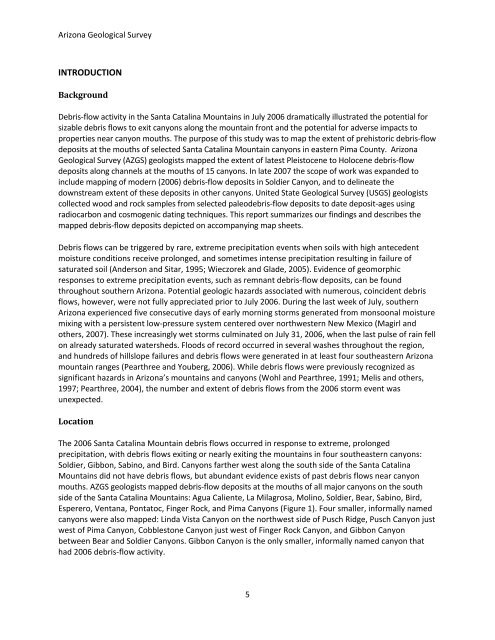Arizona Geological Survey OPEN-FILE REPORT OFR 08-06
Arizona Geological Survey OPEN-FILE REPORT OFR 08-06
Arizona Geological Survey OPEN-FILE REPORT OFR 08-06
Create successful ePaper yourself
Turn your PDF publications into a flip-book with our unique Google optimized e-Paper software.
<strong>Arizona</strong> <strong>Geological</strong> <strong>Survey</strong><br />
INTRODUCTION<br />
Background<br />
Debris‐flow activity in the Santa Catalina Mountains in July 20<strong>06</strong> dramatically illustrated the potential for<br />
sizable debris flows to exit canyons along the mountain front and the potential for adverse impacts to<br />
properties near canyon mouths. The purpose of this study was to map the extent of prehistoric debris‐flow<br />
deposits at the mouths of selected Santa Catalina Mountain canyons in eastern Pima County. <strong>Arizona</strong><br />
<strong>Geological</strong> <strong>Survey</strong> (AZGS) geologists mapped the extent of latest Pleistocene to Holocene debris‐flow<br />
deposits along channels at the mouths of 15 canyons. In late 2007 the scope of work was expanded to<br />
include mapping of modern (20<strong>06</strong>) debris‐flow deposits in Soldier Canyon, and to delineate the<br />
downstream extent of these deposits in other canyons. United State <strong>Geological</strong> <strong>Survey</strong> (USGS) geologists<br />
collected wood and rock samples from selected paleodebris‐flow deposits to date deposit‐ages using<br />
radiocarbon and cosmogenic dating techniques. This report summarizes our findings and describes the<br />
mapped debris‐flow deposits depicted on accompanying map sheets.<br />
Debris flows can be triggered by rare, extreme precipitation events when soils with high antecedent<br />
moisture conditions receive prolonged, and sometimes intense precipitation resulting in failure of<br />
saturated soil (Anderson and Sitar, 1995; Wieczorek and Glade, 2005). Evidence of geomorphic<br />
responses to extreme precipitation events, such as remnant debris‐flow deposits, can be found<br />
throughout southern <strong>Arizona</strong>. Potential geologic hazards associated with numerous, coincident debris<br />
flows, however, were not fully appreciated prior to July 20<strong>06</strong>. During the last week of July, southern<br />
<strong>Arizona</strong> experienced five consecutive days of early morning storms generated from monsoonal moisture<br />
mixing with a persistent low‐pressure system centered over northwestern New Mexico (Magirl and<br />
others, 2007). These increasingly wet storms culminated on July 31, 20<strong>06</strong>, when the last pulse of rain fell<br />
on already saturated watersheds. Floods of record occurred in several washes throughout the region,<br />
and hundreds of hillslope failures and debris flows were generated in at least four southeastern <strong>Arizona</strong><br />
mountain ranges (Pearthree and Youberg, 20<strong>06</strong>). While debris flows were previously recognized as<br />
significant hazards in <strong>Arizona</strong>’s mountains and canyons (Wohl and Pearthree, 1991; Melis and others,<br />
1997; Pearthree, 2004), the number and extent of debris flows from the 20<strong>06</strong> storm event was<br />
unexpected.<br />
Location<br />
The 20<strong>06</strong> Santa Catalina Mountain debris flows occurred in response to extreme, prolonged<br />
precipitation, with debris flows exiting or nearly exiting the mountains in four southeastern canyons:<br />
Soldier, Gibbon, Sabino, and Bird. Canyons farther west along the south side of the Santa Catalina<br />
Mountains did not have debris flows, but abundant evidence exists of past debris flows near canyon<br />
mouths. AZGS geologists mapped debris‐flow deposits at the mouths of all major canyons on the south<br />
side of the Santa Catalina Mountains: Agua Caliente, La Milagrosa, Molino, Soldier, Bear, Sabino, Bird,<br />
Esperero, Ventana, Pontatoc, Finger Rock, and Pima Canyons (Figure 1). Four smaller, informally named<br />
canyons were also mapped: Linda Vista Canyon on the northwest side of Pusch Ridge, Pusch Canyon just<br />
west of Pima Canyon, Cobblestone Canyon just west of Finger Rock Canyon, and Gibbon Canyon<br />
between Bear and Soldier Canyons. Gibbon Canyon is the only smaller, informally named canyon that<br />
had 20<strong>06</strong> debris‐flow activity.<br />
5
















